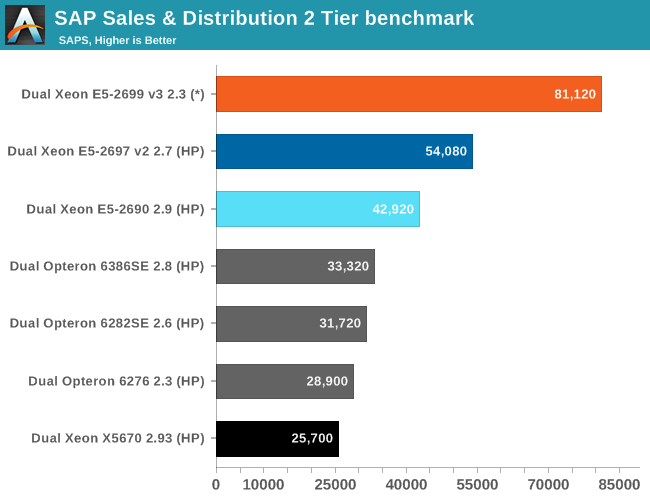Intel Xeon E5 Version 3: Up to 18 Haswell EP Cores
by Johan De Gelas on September 8, 2014 12:30 PM ESTSAP S&D
The SAP S&D 2-Tier benchmark has always been one of my favorites. This is probably the most real world benchmark of all server benchmarks done by the vendors. It is a full blown application living on top of a heavy relational database. And don't forget that SAP is one of the most successful software companies out there, the market leader of Enterprise Resource Planning.
We analyzed the SAP Benchmark in-depth in one of our earlier articles:
- Very parallel resulting in excellent scaling
- Low to medium IPC, mostly due to "branchy" code
- Somewhat limited by memory bandwidth
- Likes large caches (memory latency)
- Very sensitive to sync ("cache coherency") latency
Let us see how the new Xeon E5 fares in this ERP benchmark.

(*) Preliminary data
The SAP application is very well optimized for NUMA, so the Cluster On Die snooping mode gives a small but measureable boost (about 5%). The huge L3 cache is a blessing for SAP S&D, as it misses the L2 cache more often than most server applications. Last and but not least, once you have the caching part covered, SAP S&D scales well with more cores and it shows. Intel has been able to almost double SAP performance in about 2.5 years with one "tick-tock" cycle.










85 Comments
View All Comments
LostAlone - Saturday, September 20, 2014 - link
Given the difference in size between the two companies it's not really all that surprising though. Intel are ten times AMD's size, and I have to imagine that Intel's chip R&D department budget alone is bigger than the whole of AMD. And that is sad really, because I'm sure most of us were learning our computer science when AMD were setting the world on fire, so it's tough to see our young loves go off the rails. But Intel have the money to spend, and can pursue so many more potential avenues for improvement than AMD and that's what makes the difference.Kevin G - Monday, September 8, 2014 - link
I'm actually surprised they released the 18 core chip for the EP line. In the Ivy Bridge generation, it was the 15 core EX die that was harvested for the 12 core models. I was expecting the same thing here with the 14 core models, though more to do with power binning than raw yields.I guess with the recent TSX errata, Intel is just dumping all of the existing EX dies into the EP socket. That is a good means of clearing inventory of a notably buggy chip. When Haswell-EX formally launches, it'll be of a stepping with the TSX bug resolved.
SanX - Monday, September 8, 2014 - link
You have teased us with the claim that added FMA instructions have double floating point performance. Wow! Is this still possible to do that with FP which are already close to the limit approaching just one clock cycle? This was good review of integer related performance but please combine with Ian to continue with the FP one.JohanAnandtech - Monday, September 8, 2014 - link
Ian is working on his workstation oriented review of the latest XeonKevin G - Monday, September 8, 2014 - link
FMA is common place in many RISC architectures. The reason why we're just seeing it now on x86 is that until recently, the ISA only permitted two registers per operand.Improvements in this area maybe coming down the line even for legacy code. Intel's micro-op fusion has the potential to take an ordinary multiply and add and fuse them into one FMA operation internally. This type of optimization is something I'd like to see in a future architecture (Sky Lake?).
valarauca - Monday, September 8, 2014 - link
The Intel compiler suite I believe already convertsx *= y;
x += z;
into an FMA operation when confronted with them.
Kevin G - Monday, September 8, 2014 - link
That's with source that is going to be compiled. (And don't get me wrong, that's what a compiler should do!)Micro-op fusion works on existing binaries years old so there is no recompile necessary. However, micro-op fusion may not work in all situations depending on the actual instruction stream. (Hypothetically the fusion of a multiply and an add in an instruction stream may have to be adjacent to work but an ancient compiler could have slipped in some other instructions in between them to hide execution latencies as an optimization so it'd never work in that binary.)
DIYEyal - Monday, September 8, 2014 - link
Very interesting read.And I think I found a typo: page 5 (power optimization). It is well known that THE (not needed) Haswell HAS (is/ has been) optimized for low idle power.
vLsL2VnDmWjoTByaVLxb - Monday, September 8, 2014 - link
Colors or labeling for your HPC Power Consumption graph don't seem right.JohanAnandtech - Monday, September 8, 2014 - link
Fixed, thanks for pointing it out.